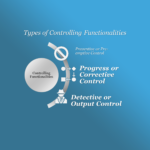Administrative Organizing in Business Management
In the function of Administrative organizing, jobs and tasks are coordinated and linked to each other, human resources are allocated to tasks and responsibilities, and the techniques and tools of implementation are determined in line with the goals of the organization…
Administrative Organizing Characteristics
Organizing is an important function for it is a process of:

- Division of Labour: in the process of organizing, every task is properly assigned to the employee who is qualified enough to carry out its responsibilities (the right person for the right job)
- Coordination: every employee in the organization is assigned to perform a specific task, and after carrying out these tasks logically and sequentially, they complement each other to lead to the achievement of the planned organizational goals
- Objectives Translation: at this stage, the planned objectives of organizing function are detailed, clarified and understood, each objective fits appropriate tasks through the progress of organizing process
- Authority-Responsibility Structure: the job of every department manager at this stage is determined according to a managerial hierarchy and different levels of job importance from highest to lowest
Communication: at the stage of organizing, the best communication methods that link managers with employees and vice versa are proposed and applied in order to achieve the best performance with the least level of errors which may be resulted from lack of communication between management and its employees
Importance of Administrative Organizing
- Administrative Organizing classifies tasks and functions of the workforce, each according to their qualifications, what leads to coordinate efforts and improve productivity when each performs a work according to their capability
- Administrative Organizing defines work relationships and communication methods between superiors and subordinates, and techniques of providing work instructions and orders
- It ensures optimum use of resources: each employee is responsible for controlling the resources allocated to them properly with regard to achieving the lowest level of waste
- It supports adaptation to developments and changes: when there is any change or development in strategies, organizational hierarchy or work relationships
It promotes business development: the process of organizing involves encouraging executives and employees and giving them enough time and space to be more creative, suggestive, and innovative
Stages of Administrative Organizing Function
- Defining the Work, then classifying according to the plans into various and several tasks and activities in order to manage them easily and efficiently
- Managerial Division: at this stage, tasks and activities compatible with each other are sorted and grouped into different categories and sections in line with the specified objectives
- Tasks Assigning: after dividing the departments, comes the process of assigning the right person to the right job or task, so that, employees are arranged depending on their specializations and qualifications to appropriate sections to carry out their duties and responsibilities
- Organizational Structure: when work begins, its relationships become clear, so that, each employee knows their direct manager, and each manager knows their subordinates
- Providing Resources: all of necessary budgets, materials and means are provided to employees and workers, and this is necessary to perform tasks and run operations perfectly
- Coordination and Scheduling: of activities logically and systematically through an accurate timetable to enable effective achievement of the organizing process objectives and organization’s goals as a whole…









